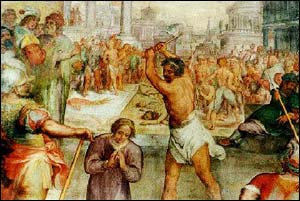July 10 – Seven Holy Noble Brethren
St. Felicitas, Martyr
The earliest list of the Roman feasts of martyrs, known as the “Depositio Martyrum” and dating from the time of Pope Liberius, i.e. about the middle of the fourth century (Ruinart, Acta sincera, Ratisbon, p. 631), mentions seven martyrs whose feast was kept on 10 July. Their remains had been deposited in four different catacombs, viz. in three cemeteries on the Via Salaria and in one on the Via Appia. Two of the martyrs, Felix and Philip, reposed in the catacomb of Priscilla; Martial, Vitalis and Alexander, in the Coemeterium Jordanorum; Silanus (or Silvanus) in the catacomb of Maximus, and Januarius in that of Prætextatus. To the name of Silanus is added the statement that his body was stolen by the Novatians (hunc Silanum martyrem Novatiani furati sunt).In the Acts of these martyrs, that certainly existed in the sixth century, since Gregory the Great refers to them in his “Homiliæ super Evangelia” (Lib. I, hom. iii, in P.L., LXXVI, 1087), it is stated that all seven were sons of Felicitas, a noble Roman lady. According to these Acts Felicitas and her seven sons were imprisoned because of their Christian Faith, at the instigation of pagan priests, during the reign of Emperor Antoninus. Before the prefect Publius they adhered firmly to their religion, and were delivered over to four judges, who condemned them to various modes of death. The division of the martyrs among four judges corresponds to the four places of their burial. St. Felicitas herself was buried in the catacomb of Maximus on the Via Salaria, beside Silanus.
These Acts were regarded as genuine by Ruinart (op. cit., 72-74), and even distinguished modern archæologists have considered them, though not in their present form corresponding entirely to the original, yet in substance based on genuine contemporary records. Recent investigations of Führer, however (see below), have shown this opinion to be hardly tenable. The earliest recension of these Acts, edited by Ruinart, does not antedate the sixth century, and appears to be based not on a Roman, but on a Greek original. Moreover, apart from the present form of the Acts, various details have been called in question. Thus, if Felicitas were really the mother of the seven martyrs honoured on 10 July, it is strange that her name does not appear in the well-known fourth-century Roman calendar. Her feast is first mentioned in the “Martyrologium Hieronymianum”, but on a different day (23 Nov.). It is, however, historically certain that she, as well as the seven martyrs called her sons in the Acts suffered for the Christian Faith. From a very early date her feast was solemnly celebrated in the Roman Church on 23 November, for on that day Gregory the Great delivered a homily in the basilica that rose above her tomb. Her body then rested in the catacomb of Maximus; in that cemetery on the Via Salaria all Roman itineraries, or guides to the burial-places of martyrs, locate her burial-place, specifying that her tomb was in a church above this catacomb (De Rossi, Roma sotterranea, I, 176-77), and that the body of her son Silanus was also there. The crypt where Felicitas was laid to rest was later enlarged into a subterranean chapel, and was rediscovered in 1885. A seventh-century fresco is yet visible on the rear wall of this chapel, representing in a group Felicitas and her seven sons, and overhead the figure of Christ bestowing upon them the eternal crown.
If St. Felicitas did not suffer martyrdom on the same occasion we have no means of determining the time of her death. In an ancient Roman edifice near the ruins of the Baths of Titus there stood in early medieval times a chapel in honour of St. Felicitas. A faded painting in this chapel represents her with her sons just as in the above-mentioned fresco in her crypt.
J.P. KIRSCH (Catholic Encyclopedia)
Nobility.org Editorial comment: —
Like St. Cecilia and many others, St. Felicitas and her seven sons share in the glory of the Roman Christian nobility that embraced martyrdom, shedding their blood, rather than renouncing the Catholic faith and their baptismal vows.In martyrdom, these Roman nobles led by example. By faithfully following themselves in the footsteps of the Redeemer, they showed other Christians that neither life nor money are our supreme values. In baptism we acquire a special bond with Our Lord and this bond of faith is our greatest supernatural good. It is more precious than life, our greatest natural good.


No comments:
Post a Comment